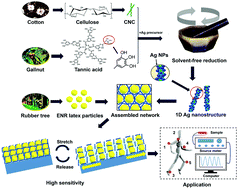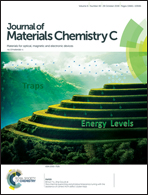Templated synthesis of a 1D Ag nanohybrid in the solid state and its organized network for strain-sensing applications†
Abstract
1-Dimensional silver (1D Ag) nanomaterials with organized structure have shown versatile applications in electronic skin, energy storage and catalysis, etc. However, conventional fabrication methods have usually suffered from various drawbacks, such as not being environment-friendly, having tedious preparation processes, and being time- and energy-consuming. Herein, we propose a simple and green strategy to produce a 1D Ag nanohybrid using cellulose nanocrystals as a template. The templated 1D Ag nanohybrid presented amphiphilic character and excellent water dispersibility, which enabled it to form an organized interconnected conductive network through self-assembly in rubber latex. The obtained composite material showed dramatically enhanced electrical conductivity and a very low percolation threshold. Importantly, this assembled conductive network exhibited extremely high sensitivity under stretching with a gauge factor up to ∼304 and outstanding durability, enduring more than 10 000 cycles of bending. The resulting strain sensor could be used to detect both small- and large-scale human motions, such as facial expressions, coughing, gesture language and limb movements. We anticipate that this templated 1D Ag nanohybrid and its assembled organized network will find applications in flexible strain sensors, electromagnetic shielding materials, artificial muscle actuators and other electronic devices.



 Please wait while we load your content...
Please wait while we load your content...